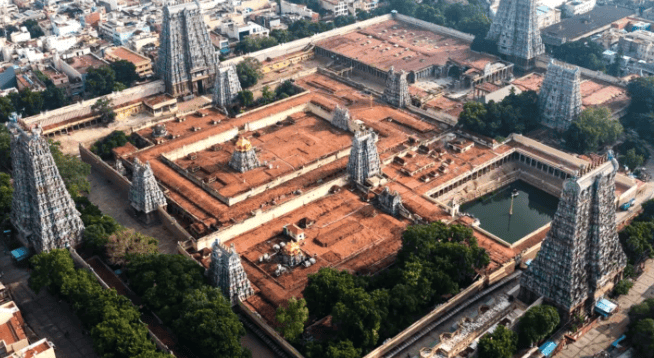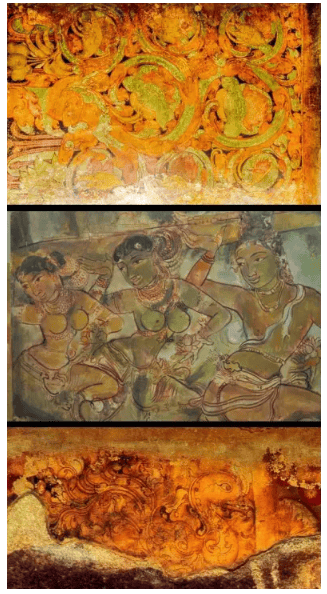UPSC Exam > UPSC Notes > History Optional for UPSC > Pandyas: Art and Architecture
Pandyas: Art and Architecture | History Optional for UPSC PDF Download
| Table of contents |

|
| Rock-Cut Temples and Structural Temples of the Pandya Period |

|
| General Features of Temple Architecture |

|
| Sculptures |

|
| Painting during the Pandyas |

|
Rock-Cut Temples and Structural Temples of the Pandya Period
Rock-Cut Temples
- Early rock-cut temples are characterized by monolithic vimanas, which are single stone structures.
- These temples are located in Thirupparankundram, Anaimalai, Karaikudi, Kalugumalai, Malaiyadikurichi, and Trichy, and were primarily dedicated to Lord Shiva and Vishnu.
- Cave temples can also be found in Kalugumalai and Trichy.
Structural Temples
- Structural temples are smaller stone temples that incorporate all the features of larger temples, such as vimana, mandapa, and sikhara, but with a simpler design.
- These temples typically include a garbhagriha(sanctum),ardhamandapa(anteroom), and mahamandapa(main hall).
- In Shiva temples, a Nandi(bull) is usually positioned in front of the mahamandapa.
- During the later Pandya period, there was a notable advancement in the construction of elegant vimanas featuring finely sculpted idols, as well as in the design of gopurams(entrance towers).
- The rectangular entrances or portals of the temples are known as gopurams, which have a pyramidal shape above the entrance.
- Over time,gopurams became more prominent than sikharas
- with gopurams being taller and more imposing while sikharas decreased in height.
- Succeeding dynasties constructed lofty gopurams with elaborate decorations.
Examples
- Groups of small temples can be found in the Tiruchirapalli district of Tamil Nadu.
- The Meenakshi Temple in Madurai and the Aranganathar Temple in Srirangam represent the pinnacle of Pandya architecture.
- Structural stone temples are located in Kumbakonam, Thiruvannamalai, Kovilpatty, Thiruppathur, Alagarkoil, and Ambasamuthram, as well as in Madurai.
- Examples of structural temples include the Siva Temple at Ambasamudhram, the Vijayanarayana Temple at Nanguneri, and the Lakshmi Narayana Temple at Athur.
- The Pandyas also constructed temples, mandapas, and gopurams at Chidambaram and Srirangam.

General Features of Temple Architecture
- Plan: Typically rectangular, with a focus on the gateways known as Gopurams.
- Gopuram Plan: Rectangular in shape.
- Ground Floor: Constructed vertically with stone.
- First Floor: Also built vertically with stone.
- Upper Floors: Pyramidal in shape, made of bricks with an inclination of 25 degrees.
- Pinnacles: Decorative peaks called shikharas are placed in odd numbers.
- Niches: Featuring heavily carved sculptures depicting Hindu mythologies.
- Pillars: Carved with images of horses and other animals.
Sri Villiputtur Andal Temple:
- Features a 12-tiered tower structure, standing 59 meters high, dedicated to the Lord of Srivilliputtur.
- Serves as the official symbol of the Government of Tamil Nadu.
- At the base of the tower, images of Panchamurtis, Thumburu, Narada, Sanatkumara, Kinnara Mithuna, the Sun, and the Moon are represented.
- The sanctum sanctorum has three doorways, accessible by a flight of stairs.
- Inside, there is a large hall with impressive wooden carvings depicting incidents from the Puranas.
Question for Pandyas: Art and ArchitectureTry yourself: Which feature is NOT commonly found in the structural temples of the Pandya period?View Solution
Sculptures
- Pandaya sculptures are known for their beauty and ornate details.
- Some sculptures are carved from a single stone.
- Sculptures from Kalugumalai, Thirupparankundram, Thirumalipuram, and Narthamalai are particularly renowned.
- Famous Sculptures include:
- Somaskandar
- Durgai
- Ganapathy
- Narasimha
- Nataraja
- The Vishnu sculpture at Kunnakudi and the Nataraja sculpture at Thirukolakkudi are of exceptional quality, comparable to sculptures from the Pallava and Chola periods.
Painting during the Pandyas
Several mural paintings from the mid-9th century can be found in the rock-cut temples of Thirumalapuram and Sittannavasal.

Thirumalapuram Painting:
- Early Pandya painting is evident in the Thirumalapuram Rock Cut Caves.
- The roof features small secondary deities (gana), including one riding a mythical lion and others displaying lotus foliage with a naturalistically depicted duck.
- These works exhibit confidence with a sober color palette of white, indigo, black, and light blue.
- A column’s capital depicts a dynamic scene of bearded figures (possibly hunters) with girls, a drum player, and several gana dancers.
Sittanavasal Painting:
- Despite significant damage, remnants of frescoes are preserved on the upper parts of columns and ceilings within the cave temple.
- Fragments of paintings in the Jain cavern at Sittannavasal reveal two superimposed layers of frescoes, along with an inscription dating around 850 AD.
- Pandyan-style frescoes from approximately 850 AD adorn the ceiling, walls, and columns of the veranda.
- One fresco depicts a richly adorned couple, another features two female dancers, and a third presents a stylized lotus tank with three men collecting flowers, fishes, birds, and various quadrupeds, including elephants.
- The lotus tank fresco, reminiscent of Ajanta frescoes, is characterized by the simplicity of characters, purity of line, and sustained colors for modeling.
- The characters in the dancer and couple compositions are more closely related to Chola paintings, indicating a later date than the lotus tank fresco.
- The central and most significant fresco in the rock-cut cave portrays a lotus tank on the ceilings of the sanctum and ardha-mandapam.
- It features naturalistic depictions of monks, animals, flowers, swans, and fishes, referring to the Samava-sarvana, an important scene in Jainism.
- The Samava-sarvana depicts an audience hall where Tirthankaras deliver sermons after attaining realization (kevala-gnana), attended by bulls, elephants, apsaras, and gods.
- The paintings were created using fresco-secco techniques, with colors derived from minerals such as lime (white), wood charcoal (black), yellow ochre (yellow), red ochre (red), ultramarine/lapis lazuli (blue), and terre verte (green).
- These decorative paintings, while similar to classical cave painting styles like those in Ajanta, show minor variations in material use and link the Ajanta paintings (4th–6th century AD) to Chola paintings of the 11th century in Thanjavur.
- Pillars feature figurines of Pandya king Srimara Srivallabha(9th century AD) and his queen paying respect to Ilam Gautaman, an acharya of Madura who created these paintings.
Question for Pandyas: Art and ArchitectureTry yourself: Which mineral was commonly used to create the color green in the Pandya style frescoes?View Solution
The document Pandyas: Art and Architecture | History Optional for UPSC is a part of the UPSC Course History Optional for UPSC.
All you need of UPSC at this link: UPSC
|
367 videos|995 docs
|
FAQs on Pandyas: Art and Architecture - History Optional for UPSC
| 1. What are the distinguishing features of Rock-Cut Temples from the Pandya Period? |  |
Ans. The Rock-Cut Temples of the Pandya Period are characterized by their intricate carvings directly hewn from rock faces. These temples often showcase elaborate pillared halls, sanctums, and detailed sculptures of deities and mythological figures. The architecture reflects a blend of Dravidian styles, emphasizing verticality and ornate decoration, with significant attention given to the entrance and interior spaces.
| 2. How do Structural Temples of the Pandya Period differ from Rock-Cut Temples? |  |
Ans. Structural Temples, unlike Rock-Cut Temples, are built using bricks, stone, and mortar, allowing for more complex and larger designs. They typically feature a garbhagriha (sanctum), an antechamber, and a towering shikhara (spire). Structural temples from the Pandya Period exhibit distinct elements such as intricate carvings, a raised platform, and a focus on horizontal rather than vertical lines compared to their rock-cut counterparts.
| 3. What are the key elements of temple architecture during the Pandya Period? |  |
Ans. Key elements of temple architecture during the Pandya Period include the use of granite and sandstone, elaborate sculptures, intricate carvings on pillars, and the incorporation of various architectural styles, such as the Dravidian style. Temples often feature a distinct vimana (tower) above the sanctum, a spacious courtyard, and decorative motifs that represent religious themes and local flora and fauna.
| 4. What types of sculptures are commonly found in Pandya temples? |  |
Ans. Sculptures in Pandya temples typically include depictions of Hindu deities such as Shiva, Vishnu, and their consorts, as well as mythological narratives and figures from epics like the Ramayana and Mahabharata. The sculptures are known for their detailed anatomy, expressive postures, and intricate ornamentation, reflecting the skill of artisans during the Pandya Period.
| 5. How did painting evolve during the Pandya Period, and what themes were prevalent? |  |
Ans. Painting during the Pandya Period saw the use of vibrant colors and intricate patterns, often found in temple murals. Common themes included religious iconography, scenes from Hindu mythology, and depictions of daily life. The paintings were characterized by their narrative style and attention to detail, often serving both aesthetic and devotional purposes within the temple context.
Related Searches















